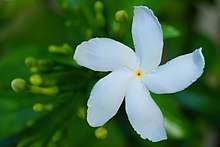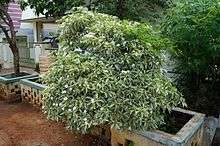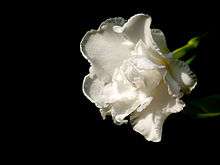Tabernaemontana divaricata
Tabernaemontana divaricata commonly called pinwheel flower,[1] crape jasmine, East India rosebay and Nero's crown[2] is an evergreen shrub native to India and now cultivated throughout South East Asia and the warmer regions of continental Asia. In zones where it is not hardy it is grown as a house/glasshouse plant for its attractive flowers and foliage. The stem exudes a milky latex when broken, whence the name milk flower.
| Tabernaemontana divaricata | |
|---|---|
 | |
| Scientific classification | |
| Kingdom: | Plantae |
| Clade: | Tracheophytes |
| Clade: | Angiosperms |
| Clade: | Eudicots |
| Clade: | Asterids |
| Order: | Gentianales |
| Family: | Apocynaceae |
| Genus: | Tabernaemontana |
| Species: | T. divaricata |
| Binomial name | |
| Tabernaemontana divaricata R.Br. ex Roem. & Schult. | |
Synonyms
- Ervatamia coronaria (Jacq.) Stapf
- Ervatamia divaricata (L.) Burkill
- Ervatamia flabelliformis Tsiang
- Ervatamia recurva (Roxb. ex Lindl.) Lace
- Ervatamia siamensis (Warb. ex Pit.) Kerr
- Jasminum zeylanicum Burm.f.
- Kopsia cochinchinensis Kuntze
- Nerium coronarium Jacq.
- Nerium divaricatum L.
- Nyctanthes acuminata Burm.f.
- Reichardia grandiflora Dennst.
- Reichardia jasminoides Dennst.
- Taberna discolor (Sw.) Miers
- Tabernaemontana citrifolia Lunan
- Tabernaemontana coronaria (Jacq.) Willd.
- Tabernaemontana discolor Sw.
- Tabernaemontana flabelliformis (Tsiang) P.T.Li
- Tabernaemontana gratissima Lindl.
- Tabernaemontana indica Willd. ex Roem. & Schult. [Illegitimate]
- Tabernaemontana lurida Van Heurck & Müll.Arg.
- Tabernaemontana recurva Roxb. ex Lindl.
- Tabernaemontana siamensis Warb. ex Pit.
- Testudipes recurva (Roxb. ex Lindl.) Markgr.
- Vinca alba Noronha[3]

Description
The plant generally grows to a height of 5–6 feet (1.5–1.8 m) and is dichotomously branched. The large shiny leaves are deep green and about 6 inches (15 cm) in length and 2 inches (5.1 cm) in width. The waxy blossoms are found in small clusters on the stem tips. The (single) flowers have the characteristic 'pinwheel' shape also seen in other genera in the family Apocynaceae such as Vinca and Nerium. Both single and double-flowered forms are cultivated, the flowers of both forms being white. The plant blooms in spring but flowers appear sporadically all year. The flowers of the single form are unscented but the double-flowered form has a pleasing fragrance.[4] More than 66 alkaloids are found in the shrub.[5]
 Tabernaemontana divaricata 'Flore Pleno'
Tabernaemontana divaricata 'Flore Pleno' Crape jasmine bunch
Crape jasmine bunch Tabernaemontana divaricata 'Pinwheel'
Tabernaemontana divaricata 'Pinwheel' Tabernaemontana divarcata yet to blossom
Tabernaemontana divarcata yet to blossom Caterpillar of Oleander hawk-moth feeding on pinwheel flower plant
Caterpillar of Oleander hawk-moth feeding on pinwheel flower plant
See also
- Iboxygaine
- Ibogamine
- Tabersonine
References
- "Tabernaemontana divaricata". Natural Resources Conservation Service PLANTS Database. USDA. Retrieved 7 December 2015.
- Medicinal Plants of India and Pakistan, Dastur J.F., pub.1962 by D.P. Taraporevala Sons and Co. Private Ltd., Mumbai, 4th Indian reprint 1977
- "The Plant List: A Working List of All Plant Species".
- The Royal Horticultural Society Dictionary of Gardening ed. Chittenden,Fred J. 2nd ed. by Synge,Patrick M. Volume IV : Pt-Zy, p.2074 (as T. coronaria). Pub. Oxford at the Clarendon Press 1965. Reprinted 1984. ISBN 0-19-869106-8
- Perry, Lily M. (1980). Medicinal Plants of East and Southeast Asia: Attributed Properties and Uses. MIT Press. ISBN 978-0-262-16076-6.
External links

